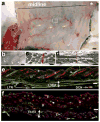The lateral thoracic nerve and the cutaneous maximus muscle--a novel in vivo model system for nerve degeneration and regeneration studies
- PMID: 22361024
- PMCID: PMC3367078
- DOI: 10.1016/j.expneurol.2012.02.006
The lateral thoracic nerve and the cutaneous maximus muscle--a novel in vivo model system for nerve degeneration and regeneration studies
Abstract
We report a novel in vivo mouse model system to study regeneration of injured motor nerve and spatiotemporal pattern of denervation in experimental nerve diseases. The lateral thoracic nerve (LTN), as a pure motor nerve, innervates the cutaneous maximus muscle (CMM) by some of the shortest and the longest motor nerve fibers in the mouse body. Its branches and nerve terminals can be imaged in whole mount preparations. Here we describe the branching pattern of the LTN and its innervation of the CMM, and characterize degeneration and regeneration over time after a LTN crush by morphological and electrophysiological analyses. We demonstrate the utility of this model in a well-established neurotoxicity paradigm and in a genetic disease model of the peripheral neuropathy. Furthermore, this system enables punch biopsies that allow repeated and multi-location examinations for LTN regeneration and CMM reinnervation over time. The presence of the LTN and the CMM in a variety of species and its easy accessibility suggests that this in vivo model system offers considerable promise for future nerve degeneration and regeneration research.
Copyright © 2012 Elsevier Inc. All rights reserved.
Conflict of interest statement
COMPETING FINANCIAL INTERESTS
The authors declare no competing financial interests.
Figures








Similar articles
-
Length-dependent axo-terminal degeneration at the neuromuscular synapses of type II muscle in SOD1 mice.Neuroscience. 2016 Jan 15;312:179-89. doi: 10.1016/j.neuroscience.2015.11.018. Epub 2015 Nov 18. Neuroscience. 2016. PMID: 26592719 Free PMC article.
-
Diabetic neuropathy: electrophysiological and morphological study of peripheral nerve degeneration and regeneration in transgenic mice that express IFNbeta in beta cells.Muscle Nerve. 2010 May;41(5):630-41. doi: 10.1002/mus.21564. Muscle Nerve. 2010. PMID: 19918773
-
Neuromuscular regeneration by buccal motoneuron B15 after peripheral nerve crush in Aplysia californica.J Neurophysiol. 1994 Oct;72(4):1897-910. doi: 10.1152/jn.1994.72.4.1897. J Neurophysiol. 1994. PMID: 7823108
-
Age affects reciprocal cellular interactions in neuromuscular synapses following peripheral nerve injury.Ageing Res Rev. 2011 Jan;10(1):43-53. doi: 10.1016/j.arr.2010.10.003. Epub 2010 Oct 11. Ageing Res Rev. 2011. PMID: 20943206 Review.
-
Nerve injury, axonal degeneration and neural regeneration: basic insights.Brain Pathol. 1999 Apr;9(2):313-25. doi: 10.1111/j.1750-3639.1999.tb00229.x. Brain Pathol. 1999. PMID: 10219748 Free PMC article. Review.
Cited by
-
Mechanisms of pruritogen-induced activation of itch nerves in isolated mouse skin.J Physiol. 2017 Jun 1;595(11):3651-3666. doi: 10.1113/JP273795. Epub 2017 Mar 19. J Physiol. 2017. PMID: 28217875 Free PMC article.
-
Identification and characterization of a potentially novel dorsal cutaneous muscle in rodents.bioRxiv [Preprint]. 2024 Jan 31:2024.01.30.577894. doi: 10.1101/2024.01.30.577894. bioRxiv. 2024. PMID: 38352413 Free PMC article. Preprint.
-
The panniculus carnosus muscle: an evolutionary enigma at the intersection of distinct research fields.J Anat. 2018 Jun 12;233(3):275-88. doi: 10.1111/joa.12840. Online ahead of print. J Anat. 2018. PMID: 29893024 Free PMC article. Review.
-
Connecting muscle development, birth defects, and evolution: An essential role for muscle connective tissue.Curr Top Dev Biol. 2019;132:137-176. doi: 10.1016/bs.ctdb.2018.12.004. Epub 2019 Jan 3. Curr Top Dev Biol. 2019. PMID: 30797508 Free PMC article. Review.
-
Length-dependent axo-terminal degeneration at the neuromuscular synapses of type II muscle in SOD1 mice.Neuroscience. 2016 Jan 15;312:179-89. doi: 10.1016/j.neuroscience.2015.11.018. Epub 2015 Nov 18. Neuroscience. 2016. PMID: 26592719 Free PMC article.
References
-
- Ayers MM, Anderson R. Development of onion bulb neuropathy in the Trembler mouse. Comparison with normal nerve maturation. Acta Neuropathol. 1975;32:43–59. - PubMed
-
- Baptista AF, Gomes JR, Oliveira JT, Santos SM, Vannier-Santos MA, Martinez AM. A new approach to assess function after sciatic nerve lesion in the mouse - adaptation of the sciatic static index. J Neurosci Methods. 2007;161:259–264. - PubMed
-
- Blight AR, McGinnis ME, Borgens RB. Cutaneus trunci muscle reflex of the guinea pig. J Comp Neurol. 1990;296:614–633. - PubMed
-
- Borgens RB, Blight AR, McGinnis ME. Behavioral recovery induced by applied electric fields after spinal cord hemisection in guinea pig. Science. 1987;238:366–369. - PubMed
Publication types
MeSH terms
Grants and funding
LinkOut - more resources
Full Text Sources

